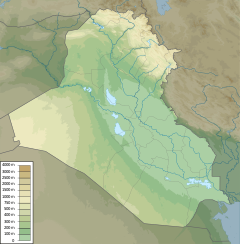Warka Vase
| Warka Vase | |
|---|---|
National Museum of Iraq, March 2019. | |
| Material | Alabaster |
| Created | c.3200–3000 BC |
| Present location | Iraq Museum, Iraq |
The Warka Vase or Uruk vase is a slim carved
The bottom register displays naturalistic components of life, including water and plants, such as date palm, barley, and wheat. On the upper portion of the lowest register, alternating rams and ewes march in a single file. The middle register conveys naked men carrying baskets of foodstuffs symbolizing offerings. Lastly, the top register depicts the goddess Inanna accepting a votive offer.[2] Inanna stands at the front portion of the gate surrounded by her richly filled shrine and storehouse (identifiable by two reed door poles with dangling banners). This scene may illustrate a reproduction of the ritual marriage between the goddess and Dumuzi, her consort that ensures Uruk's continued vitality.[2] The vase depicts an example of hierarchy being a portion of nature, and, according to anthropologist Susan Pollock, shows that social and natural hierarchies were most likely akin to each other in ancient Mesopotamia.[3]
Discovery
The vase was discovered as a collection of fragments by German Assyriologists in their sixth excavation season at Uruk in 1933/1934. The find was recorded as find number W14873 in the expedition's field book under an entry dated 2 January 1934, which read "Großes Gefäß aus Alabaster, ca. 96 cm hoch mit Flachrelief" ("large container of alabaster, circa 96 cm high with flat-reliefs").[4] The vase, which showed signs of being repaired in antiquity, stood 3 feet 1⁄4 inch (0.921 m) tall.[1] Other sources cite it as having been a slightly taller 106 cm, with an upper diameter of 36 cm.[5][6] It is named after the modern village of Warka – known as Uruk to the ancient Sumerians. A plaster cast was made of the original and this reproduction stood for many decades in room 5 of the Near-Eastern Museum in Berlin (Vorderasiatisches Museum Berlin), Germany.[5]
Decoration
The vase has three
-
Top register, Warka Vase, Iraq Museum
-
Top register, Warka Vase, Iraq Museum
-
Top register, Warka Vase, Iraq Museum
-
Top register, Warka Vase, Iraq Museum
-
Middle register, Warka Vase, Iraq Museum
-
Lower register, Warka Vase, Iraq Museum
Theft and restoration

The Warka Vase was one of the thousands of artifacts which were
The vase was later returned during an
As they struggled to lift a large object wrapped in a blanket out of the boot, the American guards on the gate raised their weapons. For a moment, a priceless 5,000-year-old vase thought to have been lost in looting after the fall of Baghdad seemed about to meet its end. But one of the men peeled back the blanket to reveal carved alabaster pieces that were clearly something extraordinary. Three feet high and weighing 600 lb intact, this was the Sacred Vase of Warka, regarded by experts as one of the most precious of all the treasures taken during looting that shocked the world in the chaos following the fall of Baghdad. Broken in antiquity and stuck together, it was once again in pieces.[9]
Soon after the vase's return, broken into 14 pieces,
The fully restored Warka Vase (museum number IM19606)[6] is now on display in the Iraq Museum.
See also
References
- ^ ISBN 0-495-00479-0.
- ^ ISBN 9780134479279.
- ISBN 0521575680.
- ^ Ralf B. Wartke, "Eine Vermißtenliste (2): Die "Warka-Vase" aus Bagdad Archived 28 September 2007 at the Wayback Machine", Frankfurter Allgemeine Zeitung 26 April 2003, Nbr 97, page 39.. English translation here. (The author is a deputy director of the Berliner Vorderasiatischen Museums).
- ^ a b Ralf B. Wartke, "Eine Vermißtenliste (2): Die "Warka-Vase" aus Bagdad Archived 28 September 2007 at the Wayback Machine", Frankfurter Allgemeine Zeitung 26 April 2003, Nbr 97, page 39.. English translatio here.
- ^ Oriental Institute, Chicago, Lost Treasures from Iraq-Warka Vase, website accessed 8 June 2007.
- ^ Schamandt-Besserat, D. Frangipane, M. (ed.). "Images of Enship". Between the Rivers and Over the Mountains. Rome: Universita di Roma: 201–209.
{{cite journal}}: Cite journal requires|journal=(help) - Oriental Institute, Chicago, Museum Photos: Iraq Museum (Baghdad, 2003), website accessed 8 June 2007.
- ^ Ch. Lamb, "Just 32 Prize Items Still Missing as Iraq’s Treasures Flood Back", The Times, 15 June 2003. Archive website accessed 8 June 2007. The original URL for this article is now dead.
- ^ Jenkins, Simon (8 June 2007). "In Iraq's four-year looting frenzy, the allies have become the vandals". The Guardian. UK. Retrieved 8 June 2007.
- ^ Memmott, Mark (18 June 2003). "Iraqi museum to repair broken 5,000-year-old vase". USA TODAY. Retrieved 29 January 2007.
- ^ Clemens D. Reichel, "Iraq Museum Project", in The Oriental Institute 2002–2003 Annual Report.
External links
- Lost Treasures from Iraq—Objects (Oriental Institute of the University of Chicago) (pre-2003 b&w photo compared with colour photograph from 12 June 2003)
- The Warka Vase (ancientworlds.net)
- Fiona Curruthers, "Iraq Museum resembled 'emergency ward'", University of Sydney News, 19 September 2003. (Colour image of pre-war Warka Vase, as well as missing "Lady of Uruk (Warka)" stone head).
- The Iraq Museum Database (hosted by the Oriental Institute, Chicago)










